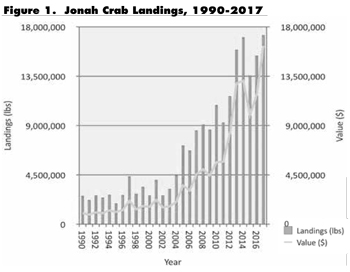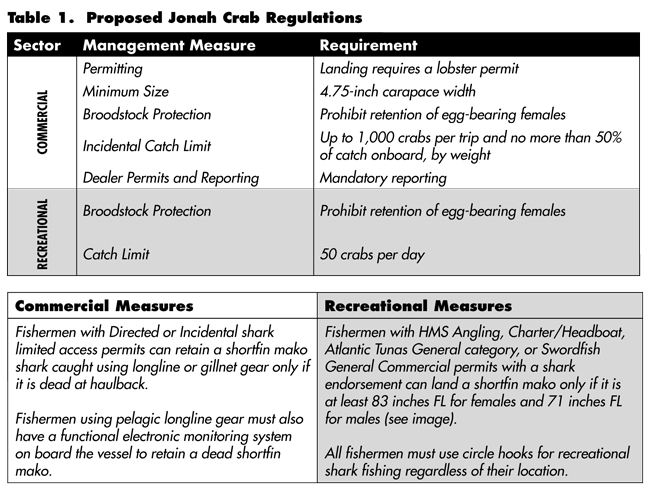Proposed Federal Jonah Crab Management

Jonah crabs may be the next species to come under federal fishery management. In 2015, the Atlantic States Marine Fisheries Commission approved an Interstate Fishery Management Plan for Jonah Crab. States within the species range (Maine through Virginia) were required to comply with the Commission’s Jonah Crab Plan in 2016. Subsequently, the Commission recommended that we take action in federal waters. In response, we recently published a rule proposing measures that complement the Commission’s recommendations.
What are we proposing?
The Commission recommended that we implement a suite of measures in federal waters. Table 1 summarizes the proposed measures.
Are there Commission recommendations that we are not proposing?
The Commission recommended two measures Commercial MeasuresRecreational MeasuresFishermen with Directed or Incidental shark limited access permits can retain a shortfin mako shark caught using longline or gillnet gear only if it is dead at haulback. Fishermen using pelagic longline gear must also have a functional electronic monitoring system on board the vessel to retain a dead shortfin mako. Fishermen with HMS Angling, Charter/Headboat, Atlantic Tunas General category, or Swordfish General Commercial permits with a shark endorsement can land a shortfin mako only if it is at least 83 inches FL for females and 71 inches FL for males (see image). All fishermen must use circle hooks for recreational shark fishing regardless of their location. that we are not proposing in this action. Harvester reporting was included in the Jonah Crab Plan and recommended for implementation. However, the Commission recently approved a separate action that expands lobster and Jonah crab harvester reporting requirements. We will consider those recommendations for both fisheries through a separate action. The Commission also adopted measures for a regulated Jonah crab claw fishery. However, states have already approved measures ranging from a prohibition on landing claws to a fully regulated, targeted claw fishery. Rather than approving a measure that would create inconsistencies between us and some states, we did not propose regulations for the claw fishery, deferring management of claw harvest to individual states.
Will this proposed action increase the number of vertical lines in the water and, therefore, increase interaction risks for large whales?
No. The rule proposes to link Jonah crab harvest to the lobster permit, and no additional traps are proposed to be allocated through this action. This action proposes to regulate the catch of Jonah crabs within the existing lobster trap limits. In addition, we are working with the Atlantic Large Whale Take Reduction Team and the Commission on the issue of whale entanglements. New measures may be introduced at a future date to decrease the entanglement risk of whales in gear with vertical lines.
When will the new measures be effective?
The recent proposed rule allows the opportunity for the public to comment on our proposed measures. Following the end of the comment period, we will develop a final rule. change the overall population trend, which has been declining since 2003. For more on the Atlantic striped bass assessment, visit the Atlantic States Fisheries Commission.That rule will finalize and approve measures for the fishery. A specific timeline is difficult to predict, but we expect the rule to be approved and effective later in 2019.
How will this rule change the fishery for current participants?
We do not expect much to change for Jonah crab harvesters. The Commission’s goal was to develop measures that capture the fishery within the parameters that existed in 2015 and prevent future expansion of the fishery. For example, the incidental catch limit was set to capture 99 percent of past trips. If the recommended measures successfully capture the existing fishery, industry can expect little to no change.
For more information, contact Allison Murphy, Sustainable Fisheries Division, at 978-281-9122 or email her at Allison.Murphy@noaa.gov.

